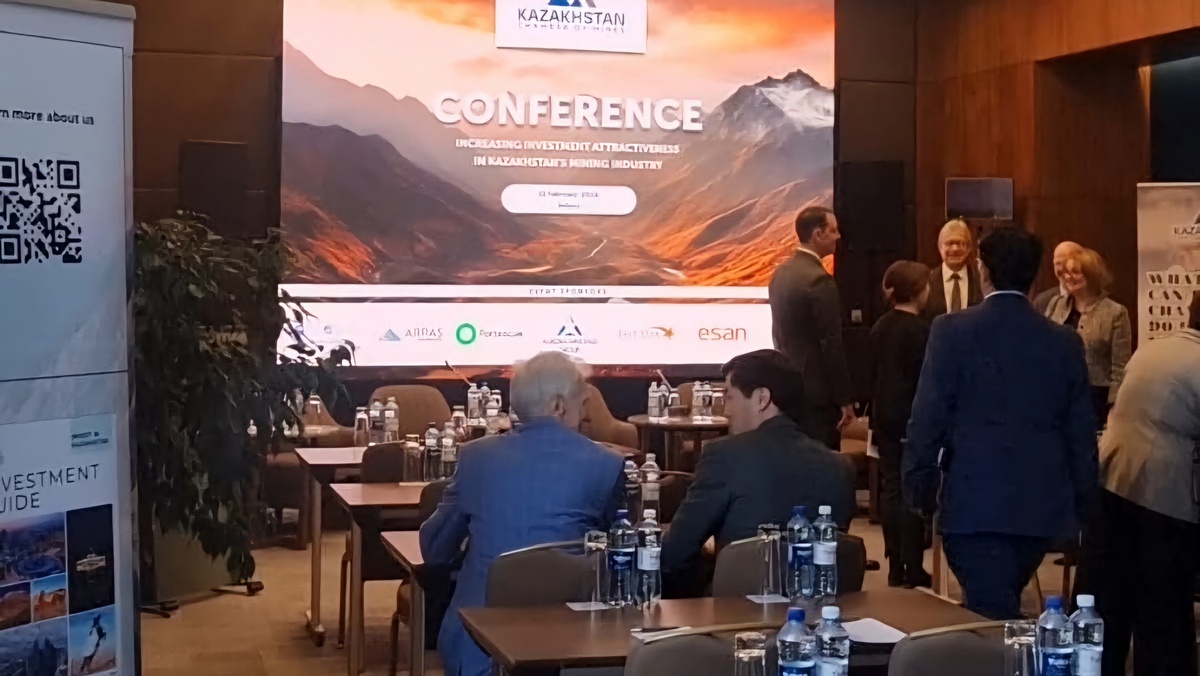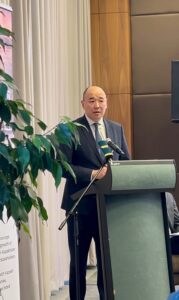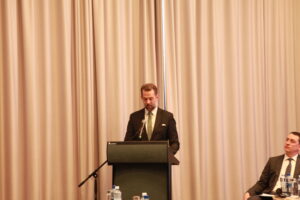ASTANA – Astana hosted a conference on Feb. 22 focusing on enhancing investment attractiveness in Kazakhstan’s mining industry. The participants discussed a range of topics relevant to the country’s mining sector, encompassing legislative frameworks, operational processes, and geological opportunities.

Photo credit: The Astana Times
Addressing the participants, Kanat Sharlapayev, Kazakhstan’s Minister of Industry and Construction, underscored the mining sector’s pivotal role in attracting foreign direct investment, totaling over $200 billion in the past decade. This constitutes approximately 60% of the country’s overall investment during the same period.

Kanat Sharlapayev, Minister of Industry and Construction emphasized Kazakhstan’s significant progress in openness and commitment to the mining sector reforms. Photo credit: The Astana Times
He emphasized Kazakhstan’s significant progress in becoming more open and committed to reforms in the mining sector.
“In 2023, 400,000 blocks of territory were opened for geological exploration. Currently, 1.5 million square kilometers are available for geological exploration, which I believe is a tremendous step for the country. Additionally, the country continues reforms to enable investor participation in Kazakhstan’s geology and mining,” he said.
The minister reiterated Kazakhstan’s commitment to adhering to international standards in geology and mining, ensuring transparency and facilitating investor participation.
Sharlapayev noted the country’s strong commitment to fully digitizing geological data and exploration and production license processes.
“It is fair to say that the country has demonstrated that commitment. Exploration licenses can now be fully obtained online. In fact, since October, we have awarded 273 exploration licenses, all done remotely via the website. We will continue this work, aiming to streamline interactions between businesses and the government in a digital format, making it easier for investors to navigate our environment,” he said.
The minister acknowledged the current importance of critical materials and their reliable supply, noting Kazakhstan’s capability to provide both.

Tim Barry, an advisory board member of the Kazakhstan Chamber of Mines, discussed the increasing demand for copper globally and Kazakhstan’s role in meeting this demand. Photo credit: Kazakhstan Chamber of Mines
“We have been a great partner globally in energy markets and critical materials. We have over 400,000 pounds of copper, and that number is only expected to rise. Our goal is to encourage exploration and investor participation in the promising opportunities that our country offers,” he stated.
United States Ambassador to Kazakhstan Daniel Rosenblum expressed optimism for Kazakhstan’s mining sector, urging focused improvements in the business and investment environment to unlock its full potential.
He provided insights on maximizing the country’s potential in attracting capital to the mining and metals sector, emphasizing predictability and transparency at all levels of government decision-making, factors that are valued by U.S. investors. This includes considerations such as rulemaking, enforcement, and taxation.
“U.S. private sector companies consistently emphasize their desire for maximum transparency,” said Rosenblum. “Equitable and fair implementation of laws and rules is essential. U.S. investors seek a level playing field and assurance that their investments will be protected through judicial institutions, such as commercial or arbitration courts.”
Rosenblum also suggested that increased private ownership in key industries such as mining would foster innovation and create new economic opportunities while enhancing overall efficiency.
Regarding Kazakhstan’s efforts, Rosenblum commended the government’s steps to reduce its presence in the economy. He emphasized that further privatization in the mining sector would enhance its attractiveness.
“We judge very positively Kazakhstan’s current focus on welcoming and even incentivizing international investment into its critical mineral sector,” he said.
Alan Hamson, Canada’s Ambassador, emphasized the favorable moment for investing in Kazakhstan’s mining industry.
“I think we can all recognize the drive to decarbonize and reduce emissions, leading to exponential growth in demand for critical minerals. Kazakhstan, like Canada, is well-positioned, offering the potential for copper, lithium, and numerous other critical minerals. This presents a generational opportunity for workers, the economy, and a net-zero future globally. It lays the foundation for a new generation of technologies,” he said.

Ambassador of Canada Alan Hamson emphasized the favorable moment for investing in Kazakhstan’s mining industry. Photo credit: Kazakhstan Chamer of Mines
Hamson echoed minister Sharlapayev’s position on the necessity of easily accessible and high-quality geological data for mining companies.
“In this regard, we are pleased with the progress in digitalization and open access to data. Canadian mining companies utilize technologies like drones and AI for superior data quality, and we aspire to introduce these technologies to Kazakhstan,” he added.
Tim Barry, an advisory board member of the Kazakhstan Chamber of Mines, discussed the increasing demand for copper globally and Kazakhstan’s role in meeting this demand.
“Copper production worldwide over the past eight years has been about 3.3 million tons per year. However, starting in 2023, the market will demand a yearly increase of seven million tons. This underscores the necessity for expanded copper supplies, with Kazakhstan emerging as a key player. The country’s Aktogai deposit currently produces 250,000 tons of copper, but to meet the demand in 2024, additional large quarries must be available, with new ones appearing annually,” he said.
Barry clarified that while sufficient copper reserves exist globally, challenges arise in their exploration, encompassing issues such as permitting, community concerns, environmental considerations, and infrastructure challenges.
“There is not a shortage of copper globally; rather, there is a shortage of viable jurisdictions. Kazakhstan is positioning itself as a significant copper jurisdiction. In April 2023, the country issued mineral licenses covering 71,000 square kilometers, surpassing the exploration areas of 100 countries. By January 2024, this figure increased to 100,000 square kilometers, demonstrating the country’s proactive exploration strategy,” he explained.
In the face of a capital shortage in the global mining and metallurgical complex, Kazakhstan seeks private capital to fund geological exploration.
“Traditional capital sources, especially for publicly traded companies, have declined. In 2010, the United Kingdom mining funds had $42 billion for mining projects, dropping to $16 billion by 2022. Canadian mining funds decreased from $16 billion in 2010 to $2 billion in 2022. Despite this, Kazakhstan continues to attract private capital for exploration,” he added.
Barry stressed the importance of jurisdiction in attracting investment, commending Kazakhstan’s recent governmental decisions conducive to the mining industry.
He also emphasized that a healthy mining industry requires excellent geology, supportive jurisdiction, community approval, and industry collaboration. With its robust geological resources, government initiatives, community support, and industry participation, Kazakhstan is well-positioned to foster a healthy mining industry adhering to best practices.


